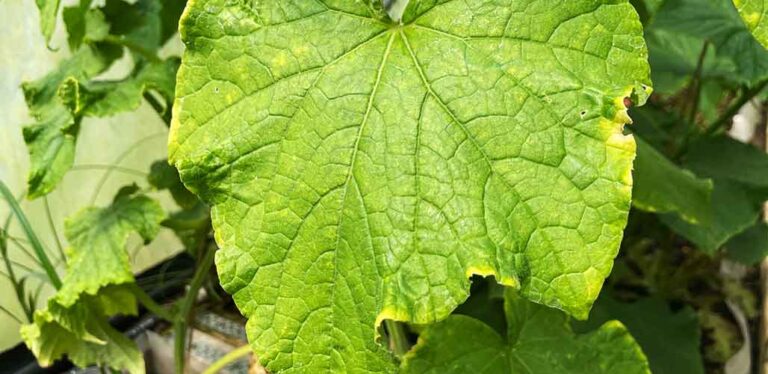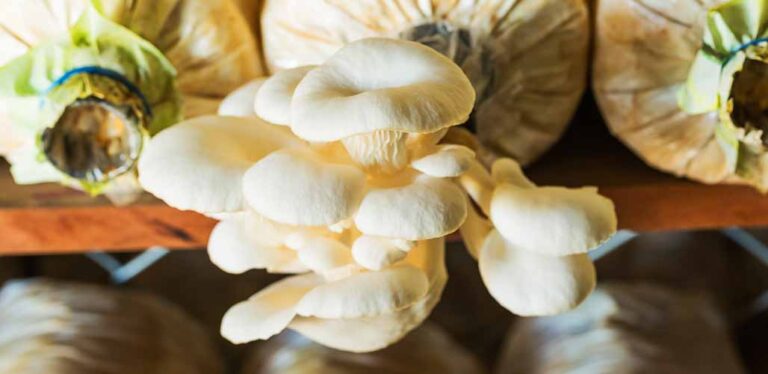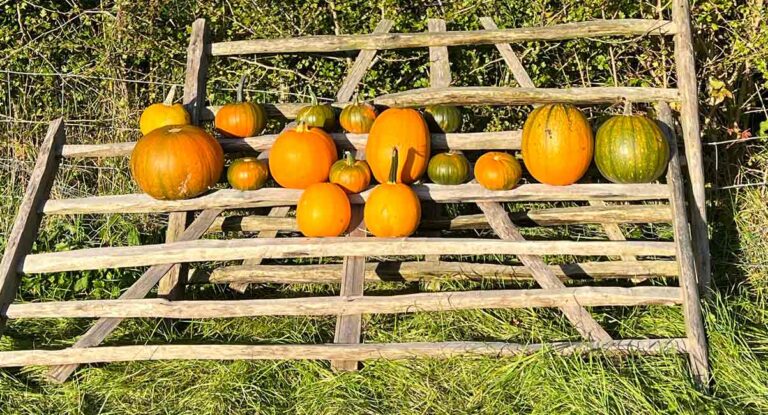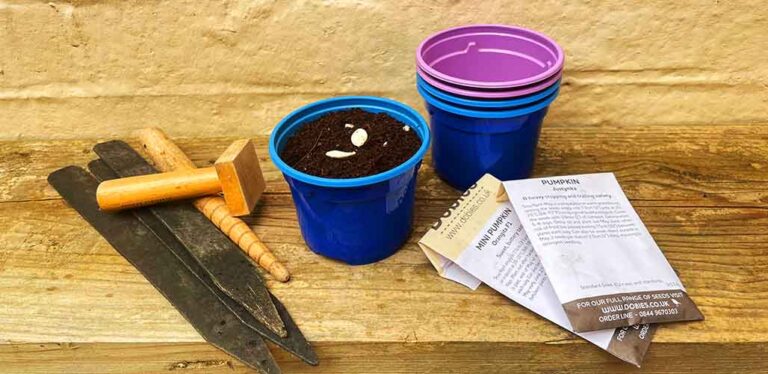How Deep Do Pumpkin Roots Grow?
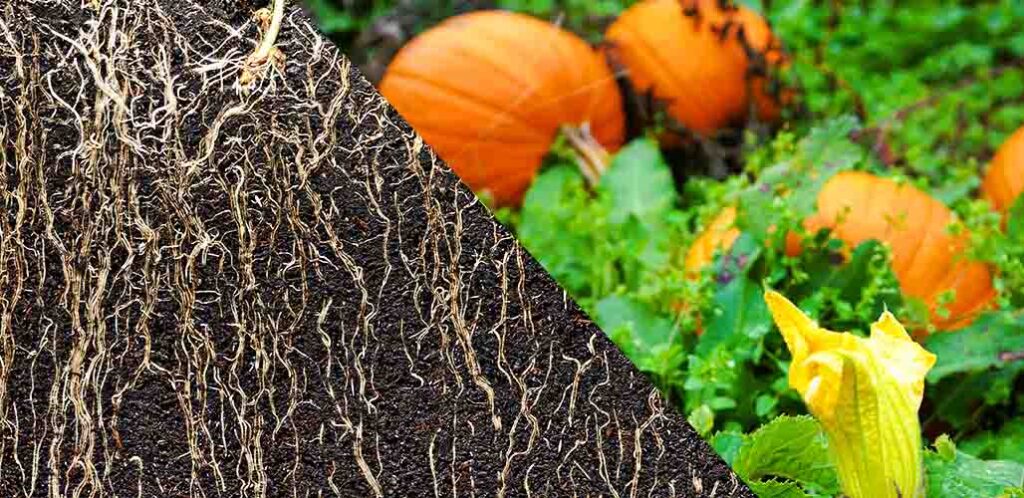
Pumpkins are notoriously hungry, thirsty, and sprawling plants. A lot of the growing advice for them centers around promoting a strong root system, so they can find enough water and food in the soil, and tolerate brief periods of drought. But how deep do pumpkin roots grow? Well, believe it or not, they can penetrate a whopping 6 feet down into the soil. And they can spread even further horizontally! Which really puts into perspective how important their roots are for supporting the plant above the ground. Here’s everything you need to know about how long pumpkin roots grow, including how different types of root support the plant in different ways. And also, how to encourage your pumpkin vines to grow strong, efficient roots.
Contents
- Pumpkins have different roots for different things
- How deep do pumpkin roots grow?
- How wide do pumpkin roots spread?
- Root growth figures from a ‘small sugar’ pumpkin crop
- Preparing your soil for happy roots
- Feeding and watering your pumpkins vine’s roots
Pumpkins have different roots for different things
As I write this, it’s nearly the time for sowing pumpkin seeds again. And like every year, I’m trying to find a compromise between the size of my growing ambitions, and the amount of growing space I actually have to work with. As well as growing area, irrigation is another important practical concern for me. All the water I use on my allotment has to be carried onto the plot from a dip tank further down the site. So, I’m probably more than averagely interested in how pumpkins take up water and nutrients from the soil! Across the plant kingdom, different species have evolved lots of different kinds of roots, in order to survive and thrive in different conditions. Pumpkins have two types of root: a tap root, and lateral roots.
1. The tap root
The tap root is the first root a pumpkin seed grows. All the lateral roots which follow branch off it. In the video near the top of this page, you can see the tap root emerge from the seed. It grows rapidly straight down for at least an inch before lateral roots start to appear. And all that before the stem and leaves even make an appearance above the soil surface!
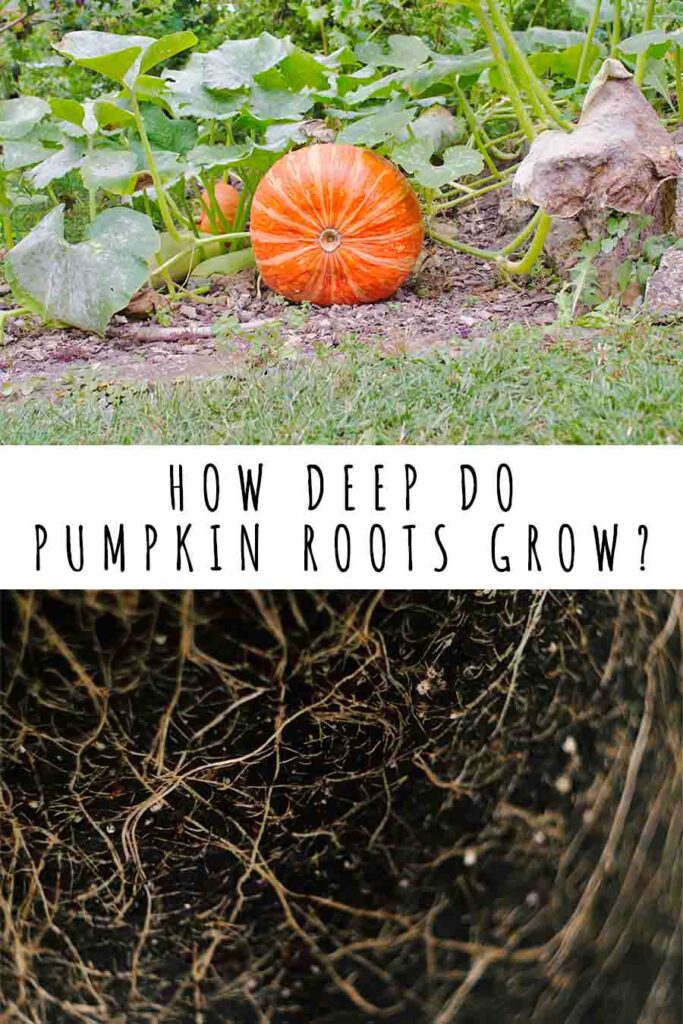
The main function of the tap root is to anchor the pumpkin vine strongly in the ground, and provide a starting point for the lateral roots. To a lesser extent it also absorbs water and nutrients from the soil. Tap roots also store any ‘extra’ energy the plant has made through photosynthesis, and release it later when the plant needs it.
2. Lateral roots
Lateral roots grow horizontally outwards from the tap root. Most of them emerge between 2 and 12 inches down from the base of the plant. Below 14 inches deep, the number of lateral roots is relatively low. So, if you could see a cross section of a pumpkin’s root system in the soil, it would be roughly T-shaped. Lateral roots branch out into a network of increasingly fine strands, each covered in millions of tiny root hairs. Their main function is to take up water and nutrients from the soil, through these root hairs.
How deep do pumpkin roots grow?
Depending on the variety, pumpkins have a deep tap root which reaches up to 6 feet below the soil surface. As a rule, the bigger the pumpkin plant and fruit, the longer the tap root. So giant pumpkins grown for shows or carving are more likely to have tap roots which exceed 5 feet long. And small pumpkins grown for eating usually have a tap root about two or three feet long.
To make sure it grows straight down, a pumpkin’s tap root is positively geotrophic. That means it has specialized cells at the tip which detects the gravitational pull from the center of the Earth, and grow toward it. Isn’t that amazing?!
How wide do pumpkin roots spread?
Even more impressive than the depth of pumpkins’ tap roots is the spread of their lateral roots. Their lateral roots extend to at least the length of their vines, and sometimes even longer. Which makes it easy to see why they don’t usually grow well in containers. And why seed packets advise planting them so far apart! As a rule of thumb:
- Large fruited varieties need to be planted 2 to 6 feet apart, in rows 5 to 12 feet apart.
- Bush varieties need to be planted 1 to 3 feet apart, in rows 3 to 6 feet apart.
Root growth figures from a ‘small sugar’ pumpkin crop
To put into perspective how much space pumpkin roots need, and how soon after germinating they need it, here are are some amazing stats from a growing trial of the pumpkin ‘Small Sugar’ in open ground:
3 weeks after sowing, when the seedlings still only had 3 true leaves, their tap roots were already 18 to 22 inches long. The lateral roots already extended 12 to 15 inches away from the base of each plant.
7 weeks after sowing, when the vines’ main stems were around 7 feet long, their tap roots had reached up to 4 feet deep. But the researchers noticed that depending on obstructions in the soil, their growth wasn’t always straight. To the tap roots were actually far longer than 4 feet! The lateral roots had spread up to 8 feet. In some areas the top foot of soil was so densely packed with lateral roots that they had sucked all the moisture out of the ground.
12 weeks after sowing, the main stems were about 16 feet long. The tap roots had reached approximately 6 feet deep. The lateral roots had grown up to 17 feet long, and from them smaller roots were growing vertically down so that the vine could access moisture many feet away from the base of the plant, and 3 or 4 feet below the soil surface. Even after lots of rain, the researchers noted that the soil was dry due to the action of such widespread roots.
Preparing your soil for happy roots
So, all of this tells us that growing pumpkins places huge demands on the soil. For the best harvest at the end of it the season they need ample access to space, moisture, and nutrients. Before your even get started, here are some things to have ready:
- Space, and lots of it. This is especially true if you want to grow big pumpkins for carving. Your pumpkins roots will spread far and wide and compete with other plants for resources in the soil. If your pumpkins are planted too closely along other winter squashes, it could result in a disappointing number and size of fruit. If they’re planted right next to other crops, it could be the other crops which struggle. In small spaces, stick to small fruiting varieties, like Jack Be Little.
- Loamy, sandy loam, or loamy sand soil. In other words, a favorable balance of free-draining, and water retentive. Pumpkins tend to suffer in clay soils, even though they hold moisture well, because their roots struggle to make headway through the heavy soil structure. For the same reason, pumpkins often disappoint in soils that have been heavily compacted by standing or walking on them. At the opposite extreme, sandy soils that don’t hold on to enough moisture are also tricky to grow pumpkins in.
- Manure! Or alternatively, some rich compost. Dress the place where you’re going to grow your pumpkins with 2 or 3 inches of manure or compost, the preceding fall. This gives the worms lots of time to dig it in for you, so that all the goodness is waiting in the the right place for your pumpkins’ roots to access in summer.
Feeding and watering your pumpkins vine’s roots
How much and how often you feed and water your pumpkins can have a big effect on how wide and deep their roots grow. Which in turn influences their yield, and how resistant they are to periods of drought.
The most important times to make sure your pumpkin plants are kept evenly watered are:
- Right after sowing, to maximize their germination rate.
- When they start to flower, to maximize how many fruit set.
- And in the last two weeks before you harvest your fruit, to ensure maximize their size and quality.
Pumpkin tap roots provide drought tolerance. So encourage your vines to put down deep tap roots by watering deeply once a week, rather than a light sprinkle every day. If your soil drains quickly, plant your pumpkins in a crater or furrow, so the water sinks into the soil at the base of the plant, rather than running off sideways. Conversely, if your soil is heavy and drains slowly, plant pumpkins on a mound, so that water doesn’t sit in a puddle at their base and cause the stems to rot.
Watering deeply also encourages lateral roots to grow in the right direction. Lateral roots should grow outwards and slightly downwards, but if you water lightly and frequently, they will grow upward. Which makes the plant less resilient to dry spells in future.
To conserve moisture in the soil, mulch around your vines with compost, grass clippings, or straw. I grow my pumpkins through holes in plastic membrane, which suppresses weeds and prevents water evaporating from the soil around my plants..
How deep do pumpkin roots grow – summary
Pumpkin tap roots grow up to 6 feet deep. Giant fruiting varieties grow the longest tap roots, and small varieties stop at 2 or 3 feet deep. Pumpkins also grow enormous networks of lateral roots, at least as long as their longest branch above the surface. To promote a strong root system, sow your seeds in loamy soil, and water your pumpkin vines deeply once a week in dry weather.
Let us know what pumpkin varieties you grow, and how much space they need, in the comments box down below!

